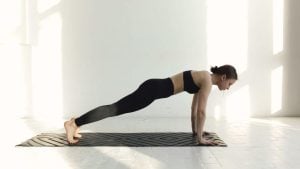This calisthenics workout plan for beginners is a perfect way to start bodyweight training at home. The main focus of the program is to strengthen both the upper body and lower body with a special focus on the core (abs and lower back). The best part is that you can train your entire body without any equipment.
Most exercises are suitable for total beginners but if you're unsure, please check with your doctor whether you are allowed to perform them. Don't take everything as gospel, it is impossible to create a program that fits everyone's needs. This calisthenics workout plan serves as a guide, and it doesn't feel bad about not being able to complete all the prescribed sets and reps.
Before we dive into the workout plan, let me recommend a few resources that will help you get started with calisthenics.
Recommended Resources for Calisthenics When Starting Out
In the beginning, it is overwhelming to find the best sources of information. I'd like to save you some time and point you in a direction that will set you on your way with a significant head start.
Calisthenics Book: Get Smart To Filter Through The Noise
When I first got into calisthenics, I spent hours falling down YouTube rabbit holes, trying to piece together some kind of training plan. One guy said I should train like a gymnast, another told me to only do high-rep push-ups. It was honestly confusing.
Here you can find a ▶️ list of the best calisthenics books that I read and found the most insightful.
What made the biggest difference wasn’t another flashy tutorial—it was sitting down with a solid book that actually explained how the body works. Reading about how muscles, tendons, and joints respond to different types of training gave me a deeper understanding of what I was doing and why. Instead of just copying exercises, I started to understand things like leverage, range of motion, and progressive overload. That changed everything.
A good calisthenics book lays out the principles of strength building in a way that helps you manage your expectations and avoid common mistakes. It explains why certain moves feel impossible at first, and how to break them down step by step. It also dives into mobility, which is something I completely overlooked until I realized my lack of shoulder flexibility was holding me back more than my strength. And when you start understanding how hypertrophy actually works with bodyweight training—how to manipulate volume, tempo, and intensity—it becomes easier to see real progress without second-guessing every workout.
Most importantly, reading gave me the ability to filter through all the noise online. Once you have a foundation in how your body moves and adapts, you can spot gimmicks a mile away. You stop chasing shortcuts and start building something solid. If you’re just getting into calisthenics, I really recommend taking the time to read one of the better books out there—it’s a slower start, maybe, but it gives you tools that will save you a lot of frustration down the road.
Undoubtedly, the best book for calisthenics is "Overcoming Gravity" which is considered the "bible of calisthenics". It gives you a solid theoretical foundation that you can use to maximize your training benefit. It's not a fluffy, easy read but definitely worth having it on your bookshelf. It's a forever book that you will go back to again and again.

Average Rating: 4.7
- High quality writing and structure
- Thorough and thoughtful
- Customizable programs
- Solid progressions system
- Not ideal for beginners
Pros & Cons
Pros
- This book is highly detailed, covering everything needed for bodyweight and gymnastics-based strength training, including program construction, movement progressions, and exercise descriptions with illustrations.
- Instead of providing a set workout plan, the book teaches readers how to create their own progressive workout programs, tailored to their specific goals, fitness levels, and preferences. It encourages self-sufficiency in designing programs.
- The book explains how to progress from basic to advanced exercises (e.g., achieving ring muscle-ups), with plenty of illustrations and descriptions to support this process.
- The author delves deep into programming, training principles, and goal-setting, offering guidance that can be applied to various fitness goals.
- The book is well-organized, with no fluff, providing precise, systematic advice that is applicable to both exercise and life.
Cons
- Some of the starting exercises are difficult for complete beginners, and the book may be overwhelming without prior experience in calisthenics or basic fitness.
- The book demands time and mental investment to read, understand, and apply the principles; it’s not a quick-and-easy guide.
Bottom Line
Calisthenics Apps: Just Follow The Plan
After reading a good book and getting the basics down, using a calisthenics app was what really helped me stick to the plan—especially on busy days when I didn’t have the time or energy to think about what to do next. Back then, the selection of apps was very limited, unlike today.
Check out my picks for the ▶️ list of the best calisthenics apps, where I list the pros and cons of each app.
For someone who’s just starting out, an app takes away the guesswork. You don’t need to worry about designing your own workouts or wondering if you’re doing enough. Everything’s laid out for you: what to train, how many sets, how long to rest. It’s perfect if you have no experience with exercising or if the idea of creating your own plan feels overwhelming. And honestly, not everyone wants to spend hours researching training methods—some of us just want to open an app and get started.
What I also really like is how most good apps include some kind of gamification. Whether it’s unlocking new levels, earning badges, or tracking personal bests, those little milestones keep you motivated in a way that’s surprisingly effective. It makes training feel like progress, not just effort. And when you’re building a new habit, especially something as challenging as calisthenics, that extra nudge can make all the difference.
I have tested most of the apps over the years, and what I found was that the best ones are not always the ones that are the most popular or most expensive.

Average Rating: 4.9
Annual Price: $44.99 or $35.99 20% OFF with promo code
Pros & Cons
Pros
- Advanced progress tracking
- Very capable free version with no ads.
- Well designed personalized journeys and skill trees
- Large exercise library with over 1300 exercises
- Frequent updates
- You can follow your friends' workouts
Cons
- No Apple Watch app
- Slightly complex user interface
Bottom Line
For more info about the app check out our full Calistree app review.
Get The Best Calisthenics Equipment For Your Budget And Goals
Another thing I always recommend—once you’ve built some consistency—is to start looking into getting the right calisthenics equipment for your goals and budget. That said, if you’re a total beginner, don’t worry: you don’t need any equipment to get started. One of the best things about calisthenics is that you can train every major muscle group using just your bodyweight.
Push-ups, squats, planks, glute bridges, wall handstands, and even basic pull movements can all be done without any gear at all. So if you’re just getting into it, focus on learning proper form and building strength first. You can go a long way with nothing but a bit of floor space and a consistent routine.
But as you progress and want to unlock more exercises or work toward advanced skills, having a few key pieces of equipment really opens up your training options. You don’t need to buy everything at once—start with what makes sense for your space and goals. Here’s a short list of the most useful calisthenics tools that I’ve personally used and recommend:
- Sturdy Pull-up bar – essential for developing a strong grip, back muscles and practicing advanced moves like a front lever
- Quality Wooden Gymnastics rings – incredibly versatile and perfect for scalable pushing and pulling exercises
- Quality Rubber Resistance bands – great for assisted movements, mobility work, and adding resistance
- Stable Wooden Parallettes – useful for push-up variations, L-sits, handstands, and planche training
- Adjustable Metal Dip bars – helpful for building pushing strength, weighted dips, but also for Australian pull-ups and front lever progression exercises.
- Calisthenics-friendly minimalist shoes – minimalist, grippy, and stable footwear for training
- Cheap Grippy calisthenics gloves – optional, but great for grip and hand protection, especially outdoors when it's cold
If I had to pick just two pieces of equipment to train calisthenics at home, it would be these gymnastics rings and these resistance bands—hands down. As long as you have a place to hang them (a pull-up bar, sturdy beam, or even a tree branch), rings give you an entire gym’s worth of exercises in one compact, portable setup. You can do rows, push-ups, dips, pull-ups, L-sits, even muscle-up progressions—all with one tool. They also engage your stabilizers way more than fixed bars, which builds raw, functional strength that carries over into everything else.
Pair that with a good set of resistance bands, and you’ve got a complete training setup, even if you’re not yet strong enough to lift your full bodyweight. Bands can assist you with pull-ups, dips, front lever holds, and even handstand push-up progressions. They’re also great for mobility work, prehab, and even adding resistance to squats or push-ups. Especially in the early stages, resistance bands make calisthenics more accessible while still challenging.
If you’ve got a bit more budget, I’d definitely recommend adding this freestanding pull-up bar and these dip bars. These give you more versatility in movement selection and are great if you want to start adding weight later on for exercises like weighted pull-ups or dips. Together, these four tools will cover just about everything you need to build serious strength, whether you’re training at home or on the go.
Four-week free calisthenics workout plan for beginners
Without further ado here is the best calisthenics workout plan for beginners that we could come up with. For those of you looking for the old version, you can access the 6-week workout plan here.
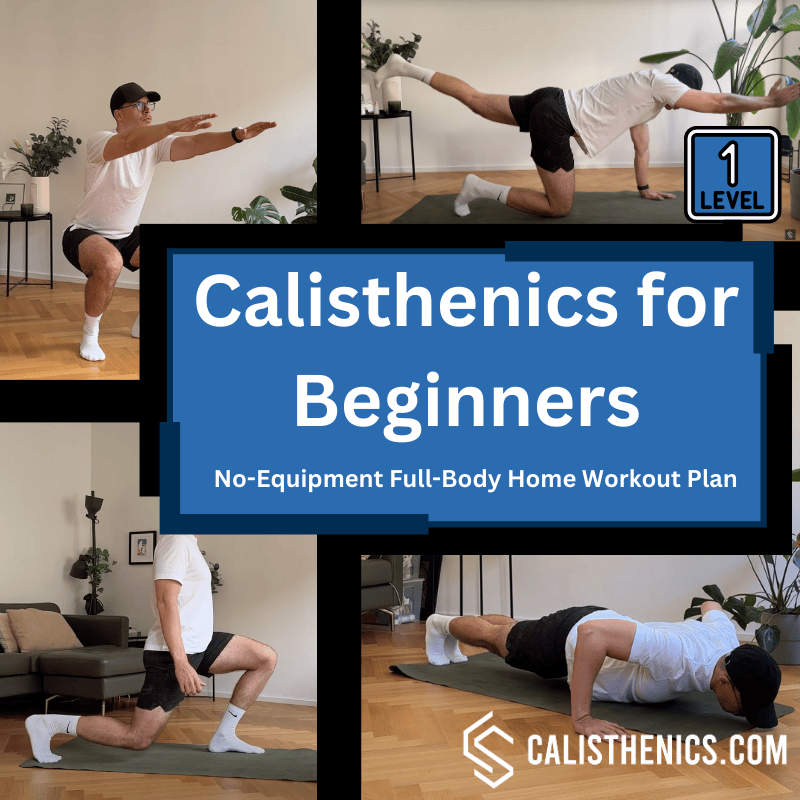
- Designed for total beginners
- Short and efficient workouts (30-40min)
- All exercises doable at home with no equipment
- 4-week program with 12 workout sessions
- Great variety of 40+ exercises
- Exercise videos and detailed guides included
Why I Designed This Workout Plan
Sometimes, a pre-designed general workout program is all you need to kickstart your fitness journey—there’s no need for a custom plan from a personal trainer, especially when you’re just starting out. I created this program because I felt there was a gap in the market. Most calisthenics programs, even those geared toward beginners, assume a certain level of strength and flexibility that many average people simply don’t have. I wanted to create something that truly builds the foundations for complete beginners.
Unlike programs that require custom guidance, this one is simple yet effective for those who are new to fitness. It’s designed to take you from no experience to being ready for more advanced routines, such as the popular Reddit Recommended Routine. I’ve included exercises that target all the key areas, progressing at a pace that suits a beginner’s body.
While a personal trainer can be helpful, the reality is that most beginners don’t need complicated plans. What they need is a program that meets them where they are, gives them clear guidance, and helps them build strength steadily. This pre-designed program offers simplicity and structure, making it easy to follow while still ensuring you’re making real progress.
What to expect from this calisthenics routine?
Are you new to fitness or looking for a simple way to get started at home? This calisthenics workout plan is designed specifically for total beginners, helping you build strength and muscle mass without the need for any equipment. It’s easy to follow, time-efficient, and adaptable to your progress. Here’s what you can expect:
Who exactly is this program for?
This program is ideal for complete beginners, especially those who lead a sedentary lifestyle or haven't been exercising regularly and want to get back to training. It’s also perfect for older individuals looking for a safe and effective way to exercise at home. In addition, it’s a great fit for people with busy lives who don’t have the time to go to the gym. The workouts are short and efficient—you can finish them faster than it would take you to commute to and from the gym! As a Level 1 program, it’s designed to help anyone get started in calisthenics, offering a solid foundation while allowing you to progress at your own pace and convenience.
Short, Effective Workouts (30-40 Minutes)
I know your time is valuable, so each workout in this program lasts between 30 to 40 minutes. This makes it easy to fit into your daily routine, ensuring that even the busiest person can get their workout done without feeling overwhelmed.
No Equipment Needed – Workout Anywhere
One of the best parts about this plan is that you can do it all at home with no equipment required. All exercises are bodyweight-based, so you can get started without needing any fancy gym gear. Whether you’re in your living room, bedroom, or backyard, this plan works for you.
4-Week Program with 12 Sessions
This program is designed to span 4 weeks with 12 workout sessions. You’ll gradually build strength and endurance with a structured progression. However, I understand that progress is different for everyone. If a particular week feels too challenging, you can simply repeat the hardest yet doable workout week until you’re ready to move forward. There’s no rush—this journey is all about your personal progress.
Over 40 Exercises to Keep You Motivated
This program features a diverse range of over 40 bodyweight exercises, meticulously designed to keep you progressing smoothly. Each exercise is carefully chosen to help you develop strength, mobility, and endurance, with the difficulty gradually increasing as you move through the weeks. This variety ensures that you’re constantly challenged while keeping the workouts engaging and fresh. From simple beginner moves to more advanced exercises, you’ll experience a full-body workout that adapts to your growing strength and fitness level. No two sessions will feel the same, helping you stay motivated and see consistent results.
Learn to do pull-ups without a pull-up bar
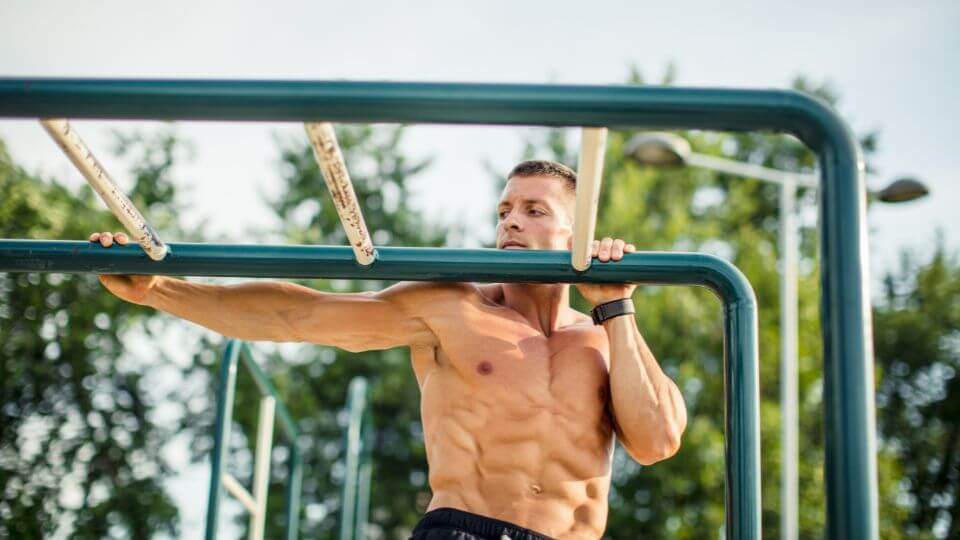
What sets this program apart is the inclusion of back-strengthening exercises, a feature often overlooked in many beginner routines. These are crucial for building a well-rounded, strong physique. Unlike typical programs that require equipment like pull-up bars for back exercises, I’ve included effective pull exercises that you can do without any equipment. Moves like seated towel rows and floorslide pull-ups will target and strengthen your back muscles, ensuring balanced progress and helping you develop both upper body strength and better posture—all without the need for a pull-up bar.
Options to Scale Difficulty
One of the key principles of this program is progressive overload, which is essential for building strength and muscle in calisthenics. Unlike weightlifting, where you can simply add more weight to the bar, calisthenics requires a more nuanced approach to increasing difficulty. That’s why progressive overload has been built into this routine as a core design principle. Throughout the program, you’ll find exercises that gradually become more challenging as your body adapts. Whether it’s increasing reps, adjusting tempo, or introducing more advanced variations, each workout is structured to ensure continuous progress. This guided progression helps you avoid plateaus and ensures you’re always working toward new strength and fitness goals.
Exercise Videos and Detailed Guides Included
I’ve made sure to include exercise videos and detailed guides for every move, ensuring that you’ll know exactly how to perform each exercise with the proper form. This not only helps prevent injury but also maximizes your results.
No matter your starting point, this plan will help you build the foundation for a stronger, fitter you. Don’t worry if your progress is slower or faster than others—just stay consistent, follow the program, and you’ll see the results. Let’s get started!
Once you completed the program and feel motivated to continue, you can create your own calisthenics workout plan following our guide so you can bang out these archer pull-ups soon at your local calisthenics park 🙂
Next Step: Beginner Push-Up, Pull-Up and Dip Workout Plan
Workout Plan: From 0 to 10 Push-Ups in 6 Weeks
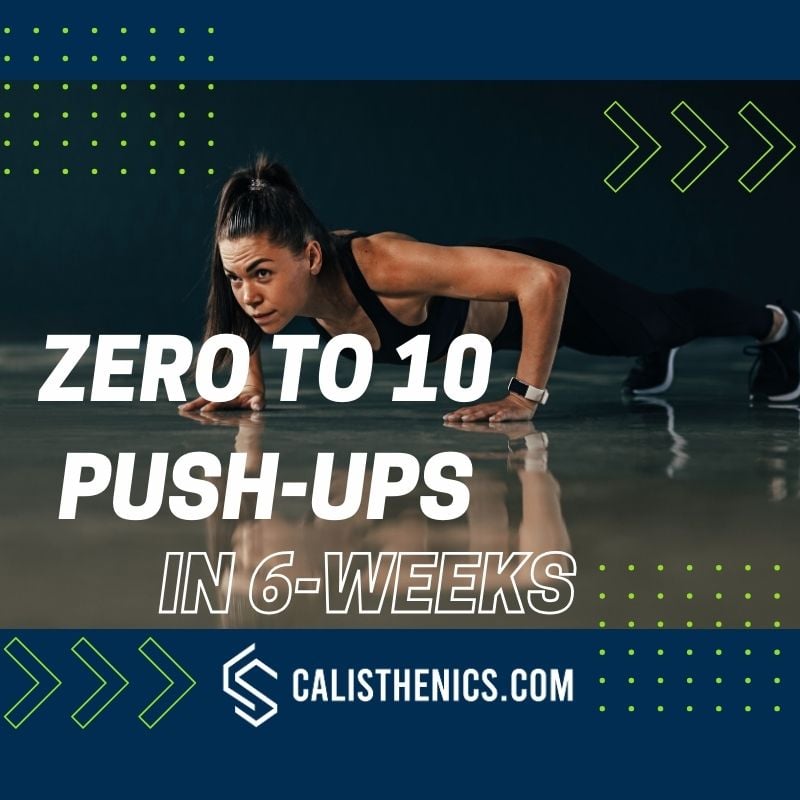
- Best program if you can't do a push-up yet or can only do a few
- Designed to improve your pushing strength
- Specifically targeted to develop the chest, triceps and shoulder muscles
- Includes 2 workouts per week (12 total)
- Each workout is less than 30 minutes long
- Each workout has a warm-up, strength, and core finisher part
Workout Plan: From 0 to 5 Pull-Ups in 6 Weeks
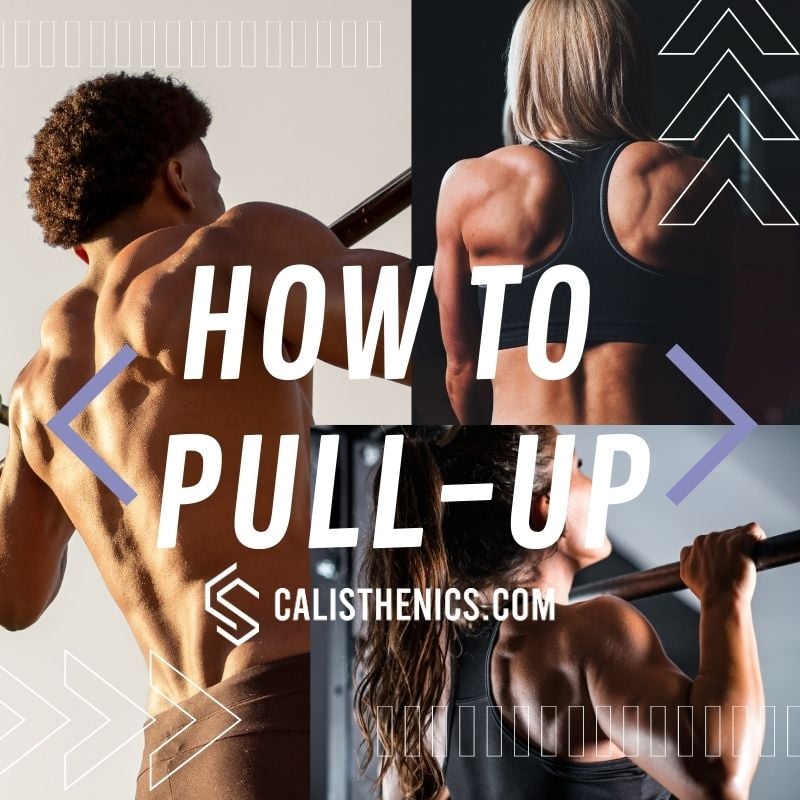
- Best program if you can't do a pull-up yet
- Designed to improve your pulling strength
- Specifically targeted to develop the back muscles, biceps and rear deltoids
- Includes 2 workouts per week (12 total)
- Each workout is 45 minutes long
- Each workout has a warm-up, strength, and HIIT part
Workout Plan: From 0 to 5 Dips in 6 Weeks

- Best if you can do push-ups, but no dips yet
- Designed to improve your pushing strength
- Targeting the upper, middle, and lower chest muscles as well as the front delts and triceps
- Includes 2 workouts per week (12 total)
- Each workout is 45 minutes long
- Each workout has a warm-up, strength, and HIIT part


